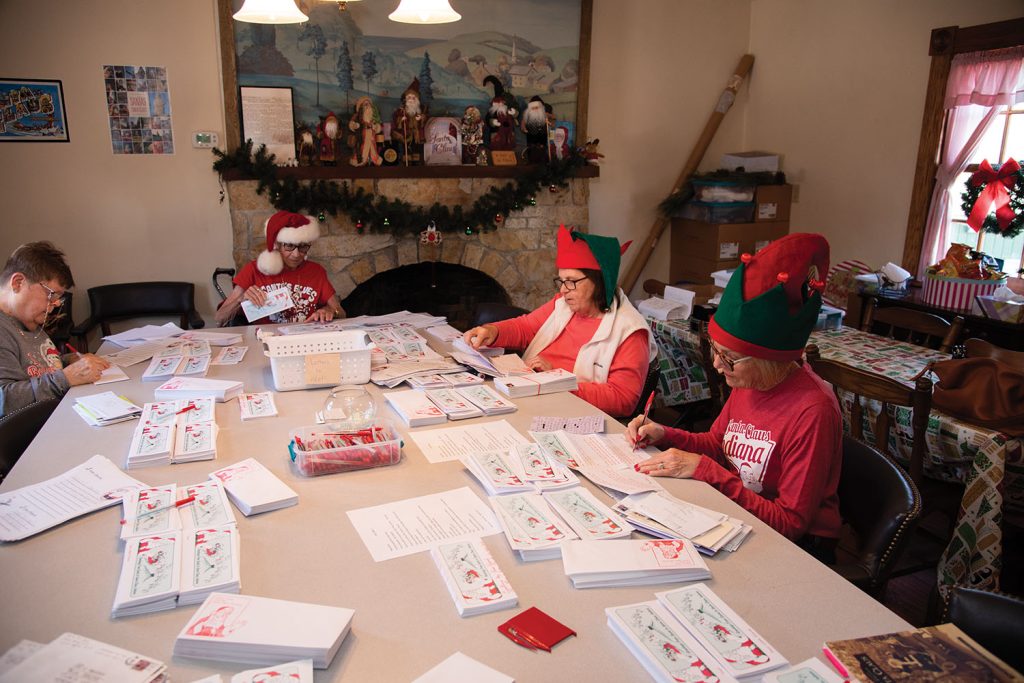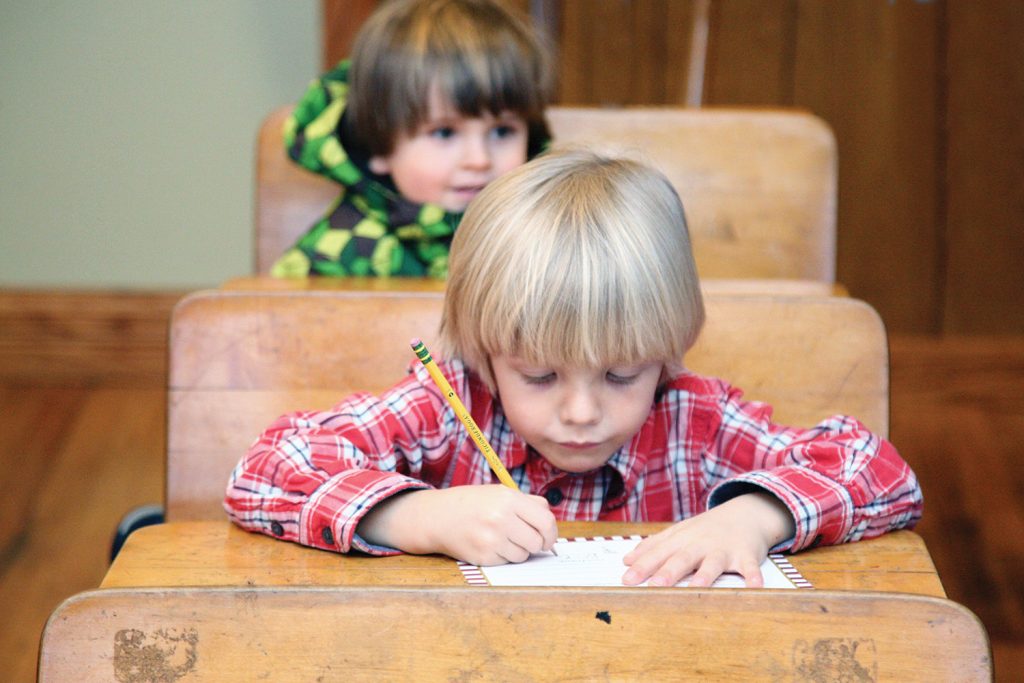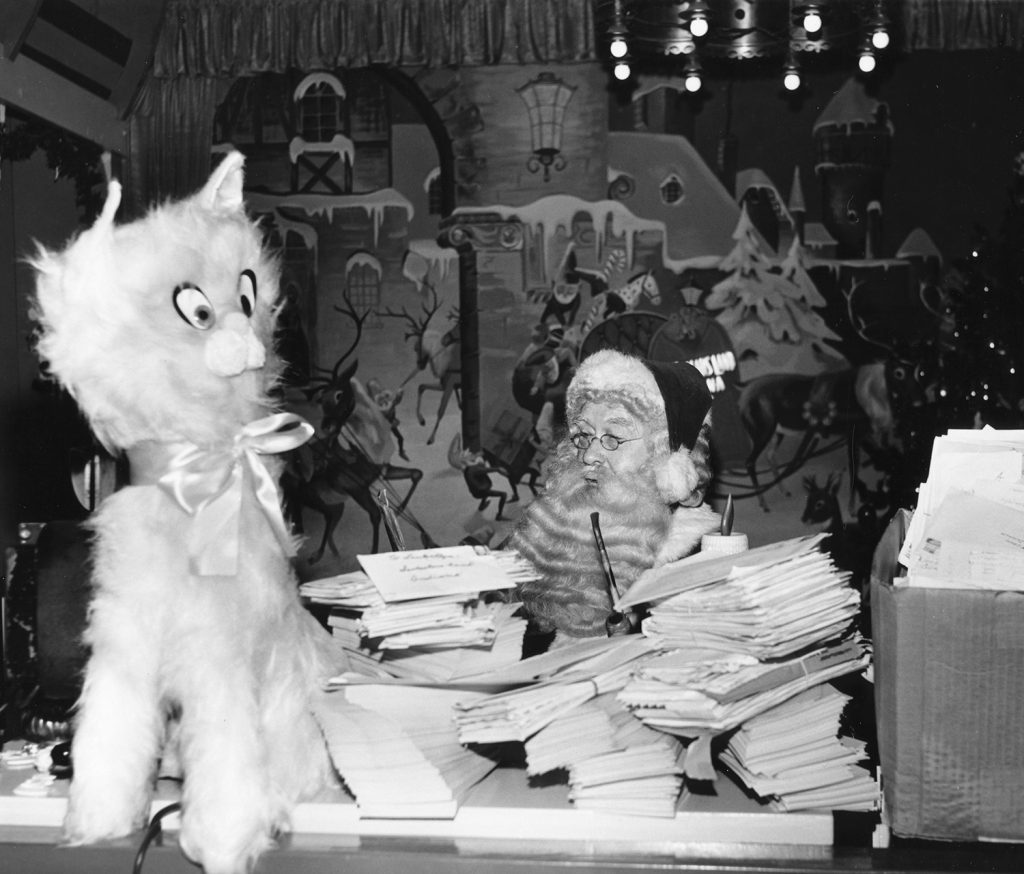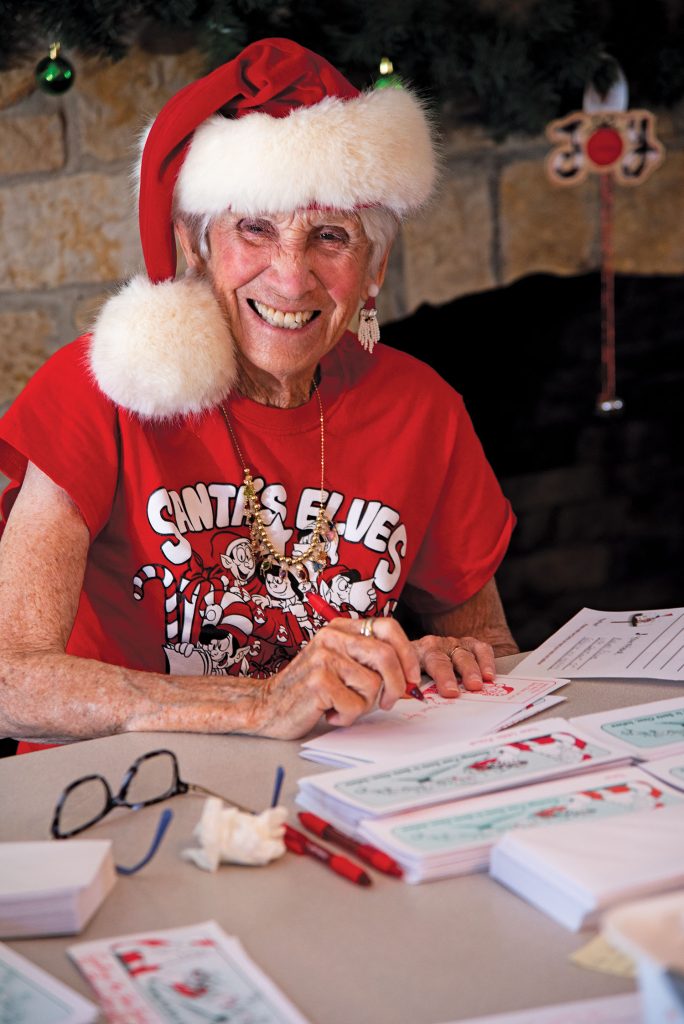
Five minutes into one of their first sessions of the season answering Santa’s mail, Santa’s Elves were stumped by a child’s undecipherable scrawl.
“Boy, I’m having trouble with this name,” said Joyce Robinson, a volunteer elf of 20 years. She handed the letter to Pat Koch, the chief elf who’s been answering Santa’s mail for almost 80 years. “Tell me what you think.”
Looking up from her stack, Koch glanced at it and said, “You’re having trouble with this name?” Then, without a hitch she read off the first name — the one printed legibly.
“No, I mean the last name,” Robinson said.
Koch hemmed on the closer, second look, “B … I … hmmmm ….”
“‘Hmmmm,’ yeah,” Robinson laughed. “It’s B-I-something. An ‘A’? ‘T’? … Oh, man.”
And, so it goes for Santa’ Elves, a group of letter-writing volunteers stationed in the back room at the original post office building in Santa Claus, Indiana. Each year, these elves gather there to answer tens of thousands of letters written to Santa that arrive from around the U.S. and the world.
If Santa were there, there’d be no problem. He’d check his list twice and discover the child’s name. But he’s in high demand this time of year. He entrusts his elves — his ghostwriters, his “Christmas spiritwriters” — to carry on in his stead.
Reading the wants and hopes of children earnestly expressed in “Dear Santa” letters, and then penning a short personal reply is a wondrous and weighty task for the volunteers. “As we work, we cry and we laugh,” Koch said.
The elves take the responsibility seriously. So, they spend several minutes trying to figure out one child’s name to ensure they spell it correctly on the return letter. Or they Google a partial address or a missing city in hopes of discovering a full address to ensure the reply’s delivery. Every child’s letter is important; every letter to Santa deserves a greeting in return.
“To me, it’s a ministry. It’s a work of love. It’s the joy it brings in a world that isn’t always joyful,” Koch noted. “It’s a miracle that children still believe in Santa Claus with all their ability to access so much information. And that belief in things we cannot see and things that are almost miraculous is so precious.”
Elves at work
While Koch, now 91, remains the energetic chief elf helping corral, train and encourage the Santa’s Elves volunteers, Kathleen Crews, director of the Museum & Village, organizes the massive letter operation.
This is her first Noël at Santa Claus. Previously, she and her husband owned and operated a buffalo park to the west of Santa Claus, and before that she was lead ranger at the Lincoln Boyhood National Memorial, Spencer County’s other claim to fame.
She’s been amazed at the volume of mail, which arrives year-round, and from where so much of it comes: Taiwan, China, Europe. “When I first started, all these letters from Russia were coming across my desk. That was back when the invasion into Ukraine had just started. I was thinking, ‘Russia, grrrrr,’” she said, feigning some hostility before softening her tone. “But the kids were writing letters to Santa. It’s about the kids.”
Most of the foreign letters are written in English, she said. When they’re not, the elves turn to assistance from area universities to help translate.
Though volunteers from around the community work the 8 a.m.-8 p.m. daily shifts through Dec. 21 (the last day letters are mailed to meet a Christmas deadline), Koch said there’s a core group of about a half dozen regular volunteers. Scheduling can be tricky; they never know if a day’s mail will bring 200 letters — or 2,000.
The elves gather around two tables in the old post office’s back room. They can choose from four preprinted letters for the correspondence. Then, they write a short personal note that references the child’s original letter. They never promise what Santa can do or tangible things he can bring. But they assure Santa’s love.
As letters are opened, some are read to the group for a chuckle or for a sigh. Funny letters are the best. The elves recall the time a child mailed the family’s house key for Santa to use because they didn’t have a chimney. Another without a chimney wondered if Santa could use the dryer vent.
“We do have some that are so sad you almost break down,” said Ed Rinehart. He’s the “chief mail elf” because he helps take letters to and from the post office. He’s also one of the few males active with the core group.
“Sometimes a child will say ‘I don’t want to live with Dad,’ or ‘My mom is dying of cancer,’” Koch said. “So, you have to be very careful. Most of the time I write something like, ‘Santa loves you and believes in you,’ just to let them know somebody cares about them.”
Sometimes a child will be worried about a loved one in the military overseas. “Santa will dip down to see how he‘s doing when over that base,“ Robinson will write. “Just something to say that Santa will definitely look in on him.”
“They’re almost like a prayer on a paper,” said Crews. “If it‘s something that seems impossible, sometimes, they ask Santa for it. And that’s heart tugging. And some just want to wish Santa a happy day, or that they’re thankful for Santa.”
Santa: The post office and man
Post offices have always been town centers in rural America. But no town has probably had its future so inextricably linked to and so mapped out by the postal service as Santa Claus, Indiana.

The Spencer County hamlet was originally known as Santa Fee. When it was large enough to apply for a post office in 1856, the Post Office Department in Washington, D.C., rejected the application because Indiana already had a similar town — Santa Fe in Miami County. Another name had to be selected.
Various tales have grown over the decades of how Santa Fee became Santa Claus. One oft-repeated one is that the town held a meeting to decide its new name on the snowy Christmas Eve of 1856. A gust of wind blew open the doors and folks heard sleigh bells in the distance … “It must be Santa Claus!”
The more likely story of its moniker is mundane. The postmaster in Fulda, about five miles due east, was handling the application. It’s believed, perhaps on a whim, he wrote “Santa Claus” above the rejected “Santa Fee” on the official application. Koch likes to point out that maybe it wasn’t all coincidence … his name was Nicholaus, … Nicholaus Fisher.
For more than 50 years after, Santa Claus, the town, hardly was noticed.
In the meantime, Santa Claus, the legend embodying Christmas spirit, grew. An article in the Smithsonian Magazine in 2015 noted that artist Thomas Nast’s depictions of Santa in Harper’s Weekly during and after the Civil War personalized and popularized Santa. And as letter writing became more common, the practice of writing “Letters to Santa” did too, especially after Nast’s 1871 depiction of Santa poring over letters from boys and girls. With no place to deliver them, the post office dumped the letters in the “Dead Letter Office.”
By 1913, bowing to requests from newspapers and organizations upset that the letters children had written went unanswered, the postmaster general allowed local post offices to release Santa letters to charity groups that wanted to answer the letters as Santa. In Santa Claus the town, Postmaster James Martin took it upon himself to begin responding to the letters that arrived.
At about the same time, according to a town history Koch wrote, post offices around the country began forwarding letters addressed simply “To Santa” to the Santa Claus post office. In 1929 and 1930, the Santa Claus post office was featured nationwide in two “Ripley’s Believe It or Not” newspaper panels. By late 1930, an avalanche of mail, 100,000 pieces in all, poured in for Santa from all over.
That’s when Jim Yellig, Koch’s father, a native of nearby Mariah Hill and restaurant owner, offered to help Martin with Santa’s mail.
Because Yellig received letters post-marked from Santa Claus while in the Navy during World War I, he was asked to portray Santa by his ship’s crew who threw a party for underprivileged children when they docked in Brooklyn. Yellig loved the experience and seeing the smiles Santa put on children’s faces. He vowed and prayed if he survived the war, he would forever portray Santa.
Returning home after the war, Yellig kept that promise. He enlisted the help of the American Legion and other local veterans, church groups, and other organizations to help the Santa Claus postmaster — and was instrumental in perpetuating the Santa’s Elves mission in 1930. In 1943, 12-year-old Pat also joined the Elves.

Santa Claus comes to town
After World War II, Louis Koch, a retired industrialist from Evansville, was disappointed that a town named after Santa had little to offer visiting children. He then developed an amusement park he called Santa Claus Land. The world’s first “theme park” opened in 1946 with a few rides, a toy shop and displays, a restaurant, and, of course, Santa.
Koch tapped none other than Yellig to become the park’s resident Santa, a position Yellig kept for 38 years until his death in 1984. In the meantime, Louis Koch’s son, Bill, came home from military service and took over the park’s operation.
In 1960, Bill Koch was reacquainted with Yellig’s daughter Pat, a nurse who had moved home to support her mom and dad after he suffered a heart attack. The old family friends soon fell in love and married. Under their oversight, Santa Claus Land matured into Holiday World. Today, Holiday World & Splashin’ Safari is internationally recognized for its wooden roller coasters, water park, and amenities. It’s still operated by Bill and Pat Koch’s children and grandchildren.
Several years after Bill Koch died in 2001, Pat founded the Santa Claus Museum & Village to begin preserving the history of the town and the legacies of her late husband and her late father. At that time, she also merged Santa’s Elves with the museum. The town’s historic first post office, moved to the museum grounds in 2012, became the official headquarters for the letter-writing organization.
Keeping Santa’s spirit alive
In the fall, students from nearby Heritage Hills High School used their Senior Volunteer Day to help at the Museum & Village. They planned to paint wheelchair ramps at the post office and the 1880 church, also moved to the grounds in 2012. Instead, rain brought the six young women inside where Koch introduced them to writing for Santa’s Elves.
Two of the seniors, Aminy Miles and Ashanty Reyes who returned during fall break to help paint, reflected on their ghostwriting experience.
“Oh, it was amazing,” noted Miles, who said not so long ago she had been on the receiving end of Santa’s greetings. “I absolutely loved it. You get all the little notes like, ‘I’ve been trying to be good,’ and all that.”
Reyes said it was nice to share the love Santa represents with others. “Santa is just something you believe in in your childhood that gives you hope — that there’s someone out there doing good. It’s that inner Christmas spirit. One letter that really got to me was a girl in middle school. She was afraid of growing up and going to high school,” Reyes continued. “It’ll be OK,” she wrote her. “Everything will work out fine. Just think positive.”
“When we do letters, it helps keep alive that childlike belief we should all have,“ Koch said. “I believe in Santa Claus because Santa is a spirit. Santa Claus will live forever — if we keep him alive.”
RICHARD G. BIEVER is senior editor of Indiana Connection.
Santa Clause, Indiana, Post Office Postmark Tips
This special picture postmark is different each year, chosen from entries submitted by art students at nearby Heritage Hills High School. The top design becomes the featured picture postmark to cancel postage stamps on holiday mail out of the Santa Claus, Indiana, Post Office. The design is revealed in early November.
It is the only post office in the world with Santa’s name. The post office began offering the postmark Dec. 1. It will be available on working days until Dec. 24.
There is no charge for postmarking. However, don’t forget to apply regular postage to your holiday mail before getting the postmark.
To get the postmark on your mail, you can go to the small-town post office to hand cancel your own mail, but you can also mail your Christmas cards to the post office. Just put your cards in a package (sturdy envelope or box), with postage stamps already on each piece of mail, and mail to: Postmaster, P.O. Box 9998, Santa Claus, IN 47579-9998. Be sure to include a note requesting the Santa Claus postmark.
To ensure a good postmark imprint, allow a space in the stamp area of about 2” by 4” (this goes on top of the regular postage/stamp); and do not enclose large or bulky items inside your mail.
Santa’s Elves Mailing Info
Santa Claus
P.O. Box 1
Santa Claus, IN 47579
Please mail your letters by mid-December to ensure a response before Christmas.
The letters from Santa Claus are made possible through Santa’s Elves, Inc., a non-profit organization. The elves happily accept donations to offset the cost of postage. Donations may be sent to Santa’s Elves, Inc., at the above address. For more information about Santa’s Elves and the Santa Claus Museum and Village, please visit SantaClausMuseum.org.





